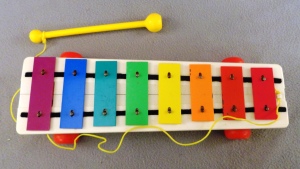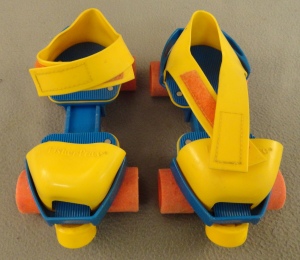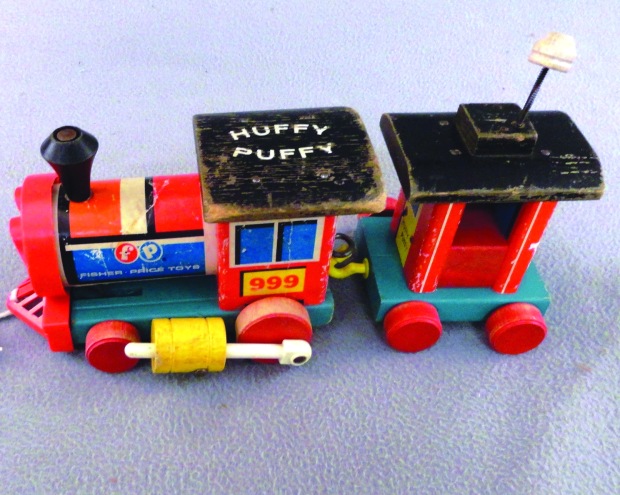When I came to The Buffalo History Museum for an internship with the Collections department in the Resource Center, one of my primary tasks consisted of cataloguing a collection of Fisher-Price toys from the 1960s through the 1990s.
The collection is a treasure trove of Fisher-Price at its best: Little People and lap desks, chime balls and a cash register, telescopes and a Toot-Toot steam engine.  There’s a rainbow grand piano, a saxophone, and a xylo-drum. The oldest toy is a 1963 “Huffy Puffy Steam Engine” with a cheerful face on the engine and a caboose; the newest toy is the brightly colored saxophone, which chirps peppy notes and dispenses soap bubbles from its bell when played.
There’s a rainbow grand piano, a saxophone, and a xylo-drum. The oldest toy is a 1963 “Huffy Puffy Steam Engine” with a cheerful face on the engine and a caboose; the newest toy is the brightly colored saxophone, which chirps peppy notes and dispenses soap bubbles from its bell when played.
Aside from getting to revel in the nostalgia that accompanied cataloguing toys from my childhood, I was also lucky enough to interview one of Fisher-Price’s retired toy engineers. Fred Robjent worked as a Product Development Engineer from 1978 to 2005. After receiving his Associate’s degree in mechanical engineering and his Bachelor’s degree in agricultural mechanization, Mr. Robjent worked at a few smaller companies before joining the Fisher-Price team. Once hired, he went through a rigorous training program. He went on to work as an engineer for the company through its periods of massive growth, its time under Quaker Oats, and finally its purchase by Mattel.
Mr. Robjent helps Walter Mayer, our Director of Collections, with the upkeep and repair of an apostolic clock in the collection. When he heard we were doing a project on Fisher-Price artifacts, he brought a number of his own personal artifacts, vintage catalogs, and limited employee edition books to the Resource Center for me to use in my research. He was happy to shed light on the design process and share his knowledge of the specific artifacts in our collection.
 Mr. Robjent personally worked on the iconic Fisher-Price roller skates. He designed and patented a mechanism that made the toy skates safer for preschoolers. If you had a pair of the skates in the early ‘90s, like I did, you might remember the yellow switch on the bottom of the skate that allowed parents to choose from three settings. One stopped the wheels from moving at all, one stopped the skates from rolling backwards, and one allowed uninhibited skating. While Mr. Robjent has eight patents in his name, this was the one that seemed to make him most proud.
Mr. Robjent personally worked on the iconic Fisher-Price roller skates. He designed and patented a mechanism that made the toy skates safer for preschoolers. If you had a pair of the skates in the early ‘90s, like I did, you might remember the yellow switch on the bottom of the skate that allowed parents to choose from three settings. One stopped the wheels from moving at all, one stopped the skates from rolling backwards, and one allowed uninhibited skating. While Mr. Robjent has eight patents in his name, this was the one that seemed to make him most proud.
Fred Robjent spoke often of the company’s desire to make the toys as safe as possible. Fisher-Price set numerous safety standards in the toy industry that remain in place today. However, when asked what he loved most about working for Fisher-Price, Mr. Robjent said that it was the company’s family atmosphere he loved most.
Samantha Vandermeade
Summer Intern, Collections Department


